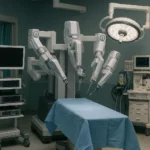Lab-Grown Lungs: Transforming Lung Disease Treatment
Imagine a world where no one has to keep waiting endlessly for an organ donor, where someone does not have to hear the words “organ transplant list” as the moment of despair. Now this dream is coming true, as scientists made a historic breakthrough: that world’s first lab-grown human lungs!
Not only in sciences, this milestone might bring a revolution in treating lung disease, interstitial lung disease, etc., or chronic respiratory diseases. Patients dying because some of the donor organ supplies fail and because the systems of their own lungs fail-this invention has a hope of bringing new life.
The Organ Transplant Crisis Today
Many thousands have met with deaths waiting for life-saving transplants in the present day. According to global statistics, the waiting list for organ transplantation includes over 100,000 people at any one time. In fact, in many developed countries, the diseases increasingly number patients dependent on organ transplants whose needs cannot be met by the pool of donors.
Moreover, transplants of lungs are also critical, and the human respiratory system is complex and very delicate; thus, lungs are among the most difficult organs to match and transplant. Unfortunately, time is not a luxury for patients who suffer from severe lung disease, including interstitial lung disease, Chronic Obstructive Pulmonary Disease (COPD), or other respiratory diseases.
As a result, many of these patients wait prolonged periods deprived of oxygen and suffer from tremendous fatigue, with a dependence on machines like ventilators; some may not emerge alive. Sadly, a large number of them would not receive the lungs they have been desperately crying out for. This reality, therefore, is sad, necessitating innovative alternatives.
However, the hope now looks more promising than ever before with lab-grown lungs, which might finally free us from the fetters of donor availability. Potentially, this solution would not only eliminate the shortage of lungs for transplantation but would also improve outcomes and survival.
What Are Lab-Grown Lungs?
Lab-grown lungs, or bioengineered lungs, are organs manufactured outside the human body using advanced techniques with stem cell therapy, tissue engineering and regenerative medicine. These aim to produce functional lungs for transplantation into humans with no need for donor organs.
How are they made?
- Scientists begin with a “scaffold“, either a decellularized lung (the cells are removed, leaving behind the lung structure), or a synthetic structure made from biocompatible materials.
- Then stem cells – special cells that can become different cell types – are introduced.
- These stem cells are seeded on the scaffold in a bioreactor, a device that mimics the environment of the human body.
- Gradually, the cells grow, divide and organize into complex lung tissues.
This work has been pioneered by several institutions, including the University of Texas Medical Branch and Columbia University. Initial trials in animals, including pigs and rats, have shown promising results. Some lab-grown lungs have survived and worked for weeks after implantation into animals.
While human trials are still on the horizon, there are early indications that bioengineered lungs could become a potential therapeutic option for end-stage lung diseases.
The Science Behind Lab-Grown Lungs and Their Potential to Save Lives
Building a functioning lung is not only a medical miracle but also the spectacle of contemporary science. So let us understand this stepwise.
Basics of Tissue Engineering: Tissue engineering is the application of cells, engineering and materials science in order to develop biological tissues. These are the steps involved in lab-grown lungs:
- Scaffolding: The structural framework that imparts the design of a human lung.
- Cell Seeding: The process of implanting stem cells into the scaffold.
- Bioreactors: These simulate breathing and blood flow and help the cells grow into functioning tissue.
- Maturation: Time is allowed for cells to develop into specialised lung tissues like bronchioles, alveoli and blood vessels.
Lab-Grown Lungs: Overcoming Challenges in Lung Transplants
Understanding the lungs: Focus on alveoli, tiny air sacs where gas exchange occurs, simplifies the complexity of the respiratory system.
- Recreating alveoli: Replicating these delicate structures is a major hurdle.
- Blood vessel growth: Solved using gene therapy and growth factors to ensure proper vascularization.
- Mimicking lung function: Bioreactors simulate breathing, helping cells grow into realistic, functional tissue.
Outcome: Years of research aim to ensure no patient dies waiting for a lung transplant.
Why lab-grown lungs are game changers?
No more Donor Dependency: The reliance upon dwindling organ donations shall no more be.
Shortened Waiting Periods: Patients may not need to wait for a match for months or even years.
Better Compatibility: Using a patient’s own stem cells to grow lungs truly reduces chances of immune rejection.
Greater Long-Term Health: Since fewer complications make recovery easier, the patient enjoys a better quality of life.
This in itself will enhance the economy and the cost of transplants is high, plus keeping rejection away means a lifelong dose of medication. Therefore lab-made lungs given to the patient will be beneficial for a healing healthcare system.
An introduction could level the field for countries with no organ transplant infrastructure, thereby giving hope to patients who would otherwise never be able to access those treatments.
Ethical and Practical Challenges Ahead
Despite the expectations, we must continue to work cautiously.
Timeline: Human trials have not yet started and it might take 5–10 more years for lab-grown lungs to be approved for clinical use.
Ethical Conundrums: Some people pose the question of whether or not growing human organs in labs crosses ethical boundaries; is this “playing God”?
Accessibility: Organs will likely be very costly to grow, at least in the beginning, making them even more likely available to a wealthy clientele.
Storage and Scalability: Organs will need to be alive until the time of transplantation. How are we going to store them? How do we scale the manufacturing?
These are valid questions. But responsible innovation and regulation, along with public discourse, will find the answer. In the end, the aim is to save lives.
Beyond Lungs: A Future of Lab-Grown Organs
Researchers exhibit possible organ growth from research into organ regeneration first in the lungs. Additionally, other organs that have recently been replicated include:
Kidneys: The most-wanted organs for organ transplant.
Liver and Heart: Early stage trials are showing potential.
Pancreas and Intestines: Under investigation for diseases such as diabetes and Crohn’s.
What if everybody lived in a world where no one needed a dialysis machine or depended on an artificial ventilator? These devices are life supports but lab-grown organs restore perfect functionality. This could be the end of transplant tourism and the illegal trade in organs-a step forward to a more just and sustainable medical system.
Organ failure will soon no longer signal death but reside in a future yet unrevealed-it continues to be in the making.
Why Should You Choose Regimen Healthcare?
- Personalized end-to-end medical travel support.
- Moreover, network of top hospitals and specialists in pulmonology diseases, stem cell therapy, and organ transplant.
- In addition, transparent, ethical processes for treatment planning.
- Furthermore, multilingual care coordinators for smooth patient communication.
- Focused on affordability and comfort.
- Finally, post-treatment follow-up and rehabilitation care support.
Why India for Advanced Lung and Organ Treatments?
- Globally acclaimed doctors and surgeons in pulmonology and transplant sciences.
- Cost-effective treatment without compromising on quality.
- Advanced medical infrastructure with global accreditations.
- Extensive research in gene therapy, stem cell therapy, and bioengineering.
- Shorter waiting time for surgeries and consultations.
- Warm hospitality and seamless visa support for medical travelers.
Conclusion
The first lab-grown human lungs in the world prove that science reaches a very great milestone. It is not simply a marvel in medicine, but a flickering hope to millions who suffer from lung diseases, interstitial lung disease, and other chronic respiratory illnesses.
As we are moving to a world where custom-made organs could save lives, let us keep on engaging, learning, and supporting.
Want to know how to check lung health? Simple tests like spirometry, CT scans, or oxygen level checks can help. Interested in how to improve lung health? Quit smoking, avoid pollution, and exercise regularly. Keep your lungs safe while science works on backups for the future.
Let us stand by stem cell therapy and gene therapy research and raise a voice for organ transplant needs. Researchers are writing the future of medicine in labs today. Be a part of this change.
Ready to take control of your lung health? Whether you’re seeking expert care for lung disease, considering a future organ transplant, or want to explore cutting-edge stem cell therapy, Regimen Healthcare can guide you every step of the way.
🌍 Contact us now to start your personalized medical journey. 📞 Book your consultation today. 💬 Our team is here to help you breathe easy again.
📞 Contact us at: +91-9310356465
🌐 Visit: www.regimenhealthcare.com
Frequently Asked Questions (FAQs)
1. What are lab-grown lungs?
Scientists create lab-grown lungs as bioengineered organs using stem cells and scaffolding structures to mimic real lung tissue.
2. Are lab-grown lungs available for patients yet?
Not yet. Human trials are expected in the next 5–10 years.
3. Can lab-grown lungs reduce the risk of organ rejection?
Yes, especially if grown from the patient’s own cells, which boosts compatibility.
4. What conditions can benefit from this innovation?
Severe respiratory diseases like COPD, interstitial lung disease, and end-stage lung failure.
5. How do I know if I need a lung transplant?
A pulmonologist can assess lung function through tests like spirometry, CT scans, and oxygen saturation levels.
6. What are the signs of poor lung health?
Shortness of breath, persistent cough, fatigue, and chest discomfort.
7. How can I improve my lung health naturally?
Stop smoking, stay active, breathe clean air, and practice deep breathing exercises.
8. Is stem cell therapy available in India for lung conditions?
Yes, it is offered by top medical centers for various pulmonology diseases.
9. Is Regimen Healthcare only for organ transplant cases?
No, we assist with a wide range of treatments including gene therapy, cancer care, and orthopedic procedures.
10. How do I start my medical journey with Regimen Healthcare?
Simply contact us through our website or helpline to get a personalized treatment plan.






